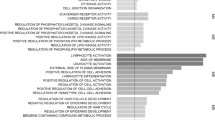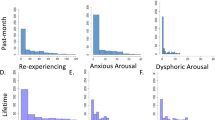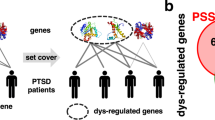Abstract
Leucocytes from soldiers exposed to battlefield-like stress (RASP: Rangers Assessment and Selection Program) were exposed in vitro to Staphylococcal enterotoxin B (SEB). We assayed SEB-induced regulation of gene expression, both in the presence and absence of severe stress, to generate two sets of gene profiles. One set of transcripts and microRNAs were specific to post-RASP SEB exposure, and another set were signatures of SEB exposure common to both the pre- and post-RASP leucocytes. Pathways and upstream regulatory analyses indicated that the post-RASP SEB-signature transcripts were manifestation of the anergic state of post-RASP leucocytes. These were further verified using expression-based predictions of cellular processes and literature searches. Specificity of the second set of transcripts to SEB exposure was verified using machine-learning algorithms on our and four other (Gene Expression Omnibus) data sets. Cell adhesion, coagulation, hypoxia and vascular endothelial growth factor-mediated vascular leakage were SEB-specific pathways even under the background of severe stress. Hsa-miR-155-3p was the top SEB exposure predictor in our data set, and C-X-C motif chemokine ligand 9 was SEB specific in all the analyzed data sets. The SEB-signature transcripts (which also showed distinct expression signatures from Yersinia pestis and dengue virus) may serve as potential biomarkers of SEB exposure even under the background of stress.
This is a preview of subscription content, access via your institution
Access options
Subscribe to this journal
Receive 6 digital issues and online access to articles
$119.00 per year
only $19.83 per issue
Buy this article
- Purchase on Springer Link
- Instant access to full article PDF
Prices may be subject to local taxes which are calculated during checkout











Similar content being viewed by others
References
Muhie S, Hammamieh R, Cummings C, Yang D, Jett M . Transcriptome characterization of immune suppression from battlefield-like stress. Genes Immun 2013; 14: 19–34.
Lindsay CD, Griffiths GD . Addressing bioterrorism concerns: options for investigating the mechanism of action of Staphylococcus aureus enterotoxin B. Hum Exp Toxicol 2013; 32: 606–619.
Cook E, Wang X, Robiou N, Fries BC . Measurement of staphylococcal enterotoxin B in serum and culture supernatant with a capture enzyme-linked immunosorbent assay. Clin Vaccine Immunol 2007; 14: 1094–1101.
Krakauer T . Cell adhesion molecules are co-receptors for staphylococcal enterotoxin B-induced T-cell activation and cytokine production. Immunol Lett 1994; 39: 121–125.
Faulkner L, Cooper A, Fantino C, Altmann DM, Sriskandan S . The mechanism of superantigen-mediated toxic shock: not a simple Th1 cytokine storm. J Immunol 2005; 175: 6870–6877.
Di Stefano A, Paulesu L, Niccolai N, Scarselli M, Soldani P, Neri P . Identification of critical residues of staphylococcal enterotoxin B for lymphomonocyte proliferation and cytokine production. J Pept Res 1998; 52: 130–136.
Hong SC, Waterbury G, Janeway CA Jr . Different superantigens interact with distinct sites in the Vbeta domain of a single T cell receptor. J Exp Med 1996; 183: 1437–1446.
Hayball JD, O'Hehir RE, Lamb JR, Lake RA . The domain structure and functional relationships in the bacterial superantigen, SEB. Biol Chem Hoppe Seyler 1995; 376: 303–309.
Tokura Y, Heald PW, Yan SL, Edelson RL . Stimulation of cutaneous T-cell lymphoma cells with superantigenic staphylococcal toxins. J Invest Dermatol 1992; 98: 33–37.
Sadegh-Nasseri S, Dalai SK, Ferris LCK, Mirshahidi S . Suboptimal engagement of the T-cell receptor by a variety of peptide-MHC ligands triggers T-cell anergy. Immunology 2010; 129: 1–7.
Kriegel MA, Adam-Klages S, Gabler C, Blank N, Schiller M, Scheidig C et al. Anti-HLA-DR-triggered monocytes mediate in vitro T cell anergy. Int Immunol 2008; 20: 601–613.
Tochiki N, Narita M, Zheng Z, Lu C, Saitoh A, Watanabe N et al. Induction of recipient cell-specific donor T-cell anergy by UV-C-irradiated recipient immature monocyte-derived dendritic cells. Bone Marrow Transplant 2008; 41: 1037–1045.
Zambricki E, Zal T, Yachi P, Shigeoka A, Sprent J, Gascoigne N et al. In vivo anergized T cells form altered immunological synapses in vitro. Am J Transplant 2006; 6: 2572–2579.
Watson ARO, Mittler JN, Lee WT . Staphylococcal enterotoxin B induces anergy to conventional peptide in memory T cells. Cell Immunol 2003; 222: 144–155.
Watson AR, Lee WT . Defective T cell receptor-mediated signal transduction in memory CD4 T lymphocytes exposed to superantigen or anti-T cell receptor antibodies. Cell Immunol 2006; 242: 80–90.
Coppola MA, Blackman MA . Bacterial superantigens reactivate antigen-specific CD8+ memory T cells. Int Immunol 1997; 9: 1393–1403.
Ge RT, Mo LH, Wu R, Liu JQ, Zhang HP, Liu Z et al. Insulin-like growth factor-1 endues monocytes with immune suppressive ability to inhibit inflammation in the intestine. Sci Rep 2015; 5: 7735.
Breiman L . Random forest. Mach Learn 2001; 45: 5–32.
Sharma P, Sahni NS, Tibshirani R, Skaane P, Urdal P, Berghagen H et al. Early detection of breast cancer based on gene-expression patterns in peripheral blood cells. Breast Cancer Res 2005; 7: R634–R644.
Tibshirani R, Hastie T, Narasimhan B, Chu G . Diagnosis of multiple cancer types by shrunken centroids of gene expression. Proc Natl Acad Sci USA 2002; 99: 6567–6572.
Arad G, Levy R, Nasie I, Hillman D, Rotfogel Z, Barash U et al. Binding of superantigen toxins into the CD28 homodimer interface is essential for induction of cytokine genes that mediate lethal shock. PLoS Biol 2011; 9: e1001149.
Tzachanis D, Freeman GJ, Hirano N, van Puijenbroek AA, Delfs MW, Berezovskaya A et al. Tob is a negative regulator of activation that is expressed in anergic and quiescent T cells. Nat Immunol 2001; 2: 1174–1182.
Gorak-Stolinska P, Kemeny DM, Noble A . Activation-induced cell death in human T cells is a suicidal process regulated by cell density but superantigen induces T cell fratricide. Cell Immunol 2002; 219: 98–107.
Kulhankova K, King J, Salgado-Pabon W . Staphylococcal toxic shock syndrome: superantigen-mediated enhancement of endotoxin shock and adaptive immune suppression. Immunol Res 2014; 59: 182–187.
Jin J, Chang DY, Kim SH, Rha KS, Mo JH, Shin EC et al. Role of hypoxia-inducible factor-1alpha expression in regulatory T cells on nasal polypogenesis. Laryngoscope 2014; 124: E151–E159.
Uchakina ON, Castillejo CM, Bridges CC, McKallip RJ . The role of hyaluronic acid in SEB-induced acute lung inflammation. Clin Immunol 2013; 146: 56–69.
Krakauer T . Update on staphylococcal superantigen-induced signaling pathways and therapeutic interventions. Toxins 2013; 5: 1629–1654.
Groom JR, Luster AD . CXCR3 in T cell function. Exp Cell Res 2011; 317: 620–631.
Tallent SM, Degrasse JA, Wang N, Mattis DM, Kranz DM . Novel platform for the detection of Staphylococcus aureus enterotoxin B in foods. Appl Environ Microbiol 2013; 79: 1422–1427.
Maere S, Heymans K, Kuiper M . BiNGO: a Cytoscape plugin to assess overrepresentation of gene ontology categories in biological networks. Bioinformatics 2005; 21: 3448–3449.
Acknowledgements
We thank Julia Scheerer and Allison Hoke for editing the manuscript and for their invaluable comments. We are grateful to The Defense Threat Reduction Agency for funding.
Human subjects protection
Research was conducted in compliance with IRB-approved human subjects protocol—no.1014 for initial collection of samples and A-16815 for continuation of data evaluation. The human use approval was obtained from the local Protection of Human subjects Office and further approved by the Human Research Protection Office, Office of Research Protections, US Army Medical Research and Materiel Command, Fort Detrick, MD, USA.
Disclaimer
The views, opinions, and/or findings contained in this report are those of the authors and should not be construed as official Department of the Army position, policy or decision, unless so designated by other official documentation. Citations of commercial organizations or trade names in this report do not constitute an official Department of the Army endorsement or approval of the products or services of these organizations.
Author information
Authors and Affiliations
Corresponding author
Ethics declarations
Competing interests
The authors declare no conflict of interest.
Additional information
Supplementary Information accompanies this paper on Genes and Immunity website
Supplementary information
Rights and permissions
About this article
Cite this article
Muhie, S., Hammamieh, R., Cummings, C. et al. Stress-caused anergy of leukocytes towards Staphylococcal enterotoxin B and exposure transcriptome signatures. Genes Immun 16, 330–346 (2015). https://doi.org/10.1038/gene.2015.16
Received:
Revised:
Accepted:
Published:
Issue Date:
DOI: https://doi.org/10.1038/gene.2015.16



